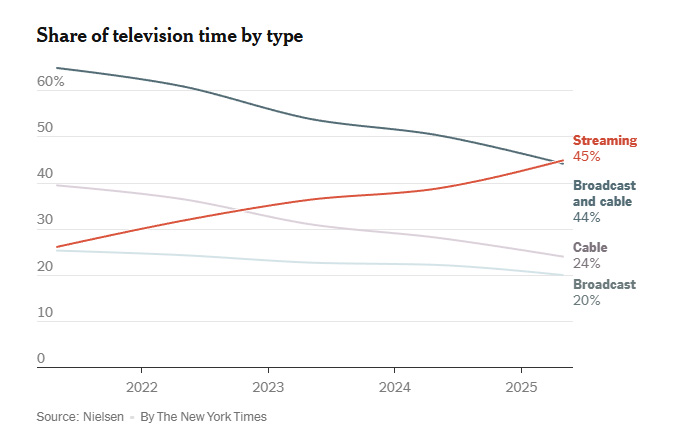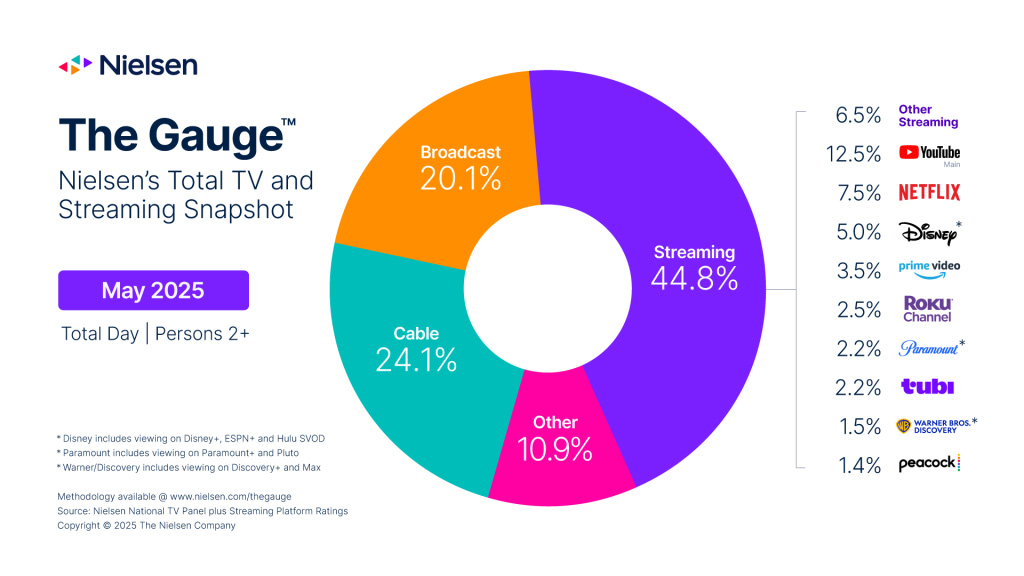
Beginning in 2021, Nielsen – a global leader in audience measurement – began tracking the share of viewership between legacy linear providers (broadcast and cable) and streaming services. Since the launch of that tracking, streaming has been continually gaining on linear TV. Now, the latest data from Nielsen shows that streaming has overtaken linear TV for the first time in May.
See more on streaming exceeding linear TV
I should note that during the four-year period that Nielsen has been tracking this trend, there have been intermittent periods when streaming exceeded linear TV. This is the first time that trend has carried on for an entire month of video viewing. That marks a milestone…
In May, Streaming accounted for 44.8% of total TV viewing. Within Linear TV – Cable accounted for 24.1% and Broadcast weighed in at 20.1%. That means the traditional linear TV viewing options combine to a total of 44.2%…quite measurably below streaming.
A Remarkable Transformation
It is remarkable when you think about it. Back in 2021 when Nielsen launched this tracking, nearly two-thirds of all TV time viewing was via cable and broadcast. Streaming claimed just a 26% share in those days.
Now, the tables have been turned and – at least for now – streaming is king of the hill. Nielsen warns that in the fall, when the NFL is active again, broadcast could return to the top…maybe.
Many Variables Fuel the Streaming Engine
There are many variables that contributed to the dramatic growth in streaming successfully overtaking linear TV. One, pointed out by a report in the New York Times, notes a dramatic shift in viewer demographics.
Initially, streaming was embraced by younger viewers. But now, viewers 65 years of age and older have joined them. According to the Times, older viewers have been drawn to streaming platforms that are free (ad-supported) and require no subscription. And these viewers watch a lot of TV – one-third of all TV viewing comes from this older age group.

Older Viewers Make an Impact
Since 2023, the Times report notes, “viewers over 65 are the fastest-growing age group for watching YouTube off a television set.” Their YouTube watch time last month grew by 106% compared to May 2023.
The Times also noted that free services, such as Tubi, Roku, and Pluto, are very popular with this older demographic group. Together, those services accounted for 5.7% of total TV time for all viewers in May, “more than Disney+ and Hulu combined.” Yes, these free services have ads, “…but for that demo, it’s not particularly jarring because they’re used to watching ads,” said Brian Fuhrer, Nielsen Senior Vice President of Product Strategy.
Dramatic Increase in Number of Streaming Services
Over these last four years, the number of streaming services has increased dramatically from the five streaming services in 2021 (Netflix, YouTube, Hulu, Prime Video, and Disney+) to a total of 11 significant streaming services now. This factor, combined with greater adoption of streaming services by users, older and others (many shifting away from linear TV), and you get an exponentially increasing effect.
The future seems to suggest even greater growth, as more and more live events – like, say, the Olympics, the Super Bowl, and many other live sporting events – migrate to a streaming platform. Even popular game shows like “Jeopardy!” and “Wheel of Fortune” will be shown on Hulu and Peacock for the first time this fall.
The Biggest Winners
The biggest winners in streaming are the OG SVOD service…Netflix…and YouTube. Netflix alone accounted for 7.5% of all TV viewing. That is a huge share only exceeded by one other company…YouTube with a 12.5% share of all TV time.
Learn more about the Nielsen data by following this link…










[…] to Strata-Gee, Nielsen has only been tracking this since 2021. As you can see, streaming’s gain have been […]